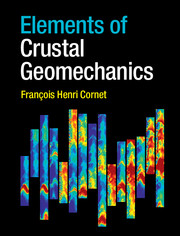Book contents
- Frontmatter
- Epigraph
- Contents
- Preface
- 1 Geomaterials and crustal geomechanics
- 2 Elements of rheology
- 3 Forces and stresses
- 4 Elements of kinematics
- 5 Elements of linear elasticity
- 6 From continuum mechanics to fluid mechanics
- 7 Elements of linear fracture mechanics
- 8 Laboratory investigations on geomaterials under compression 183
- 9 Homogenized geomaterials
- 10 Fractures and faults
- 11 Elements of seismology
- 12 Elements of solid–fluid interactions
- 13 Methods for stress field evaluation from in situ observations
- 14 Elements of stress fields and crustal rheology
- Appendix Elements of tensors in rectangular coordinates
- References
- Index
7 - Elements of linear fracture mechanics
Published online by Cambridge University Press: 05 April 2015
- Frontmatter
- Epigraph
- Contents
- Preface
- 1 Geomaterials and crustal geomechanics
- 2 Elements of rheology
- 3 Forces and stresses
- 4 Elements of kinematics
- 5 Elements of linear elasticity
- 6 From continuum mechanics to fluid mechanics
- 7 Elements of linear fracture mechanics
- 8 Laboratory investigations on geomaterials under compression 183
- 9 Homogenized geomaterials
- 10 Fractures and faults
- 11 Elements of seismology
- 12 Elements of solid–fluid interactions
- 13 Methods for stress field evaluation from in situ observations
- 14 Elements of stress fields and crustal rheology
- Appendix Elements of tensors in rectangular coordinates
- References
- Index
Summary
As pointed out in chapter 2, an elastic material may be modeled by a spring, and it is quite intuitive that a spring cannot be extended indefinitely: some maximum force, and correlatively some maximum spring extension, must exist that defines an elastic limit. When the force, or the spring extension, becomes larger than this maximum value the spring either breaks or extends further but with a nonreversible component, so that some residual deformation exists when the loading is relaxed. In a crude way, this defines two possible post-elastic behaviors: either the spring breaks, in which case the material used to make the spring is said to be brittle, or the spring deforms in a nonelastic manner, so that a permanent deformation is observed when the load is relaxed, in which case the material is said to be ductile.
While a spring may help illustrate elastic phenomena in one dimension, we saw in chapters 3–5 that for three-dimensional problems of elasticity we must introduce three dimensional stresses and strains. These quantities are second-order tensors, and elasticity implies a linear relationship between the stress and small-strain components. By comparison with the spring's behavior, we may anticipate that when the principal stress (or principal strain) magnitudes, or some function of them, become larger than some critical values, either the material breaks into pieces or it deforms according to a nonreversible process. As for the case of a spring, we call the post-elastic behavior brittle when the material fails because of the extension of fractures. We call the post-elastic behavior ductile when the material deforms continuously with occurrence of a nonreversible component. The object of the present chapter is to discuss brittle failure; ductility is discussed in chapters 8 and 9.
Different types of laboratory experiments may be conducted on rock samples to determine their strength, or more precisely to investigate the phenomena that take place after the elastic limit has been reached (e.g. Jaeger and Cook, 1979, chapter 6).
- Type
- Chapter
- Information
- Elements of Crustal Geomechanics , pp. 161 - 182Publisher: Cambridge University PressPrint publication year: 2015



